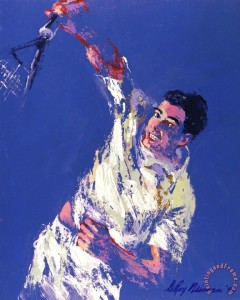- Joined
- Aug 8, 2013
- Messages
- 1,417
- Reactions
- 172
- Points
- 63

By Scoop Malinowski
Artist LeRoy Neiman has traveled the globe to paint, sketch and draw. His creations have showcased nature, humanity or any subject that arrest his attention, including sport and tennis.
“Tennis is pure,” says the artist in his studio on a sunny summer day, less than a block from Central Park in New York City. “The players come out quietly. They warm up. They have the player introductions which is very dignified. And then they start to play. There is no big to-do before it starts. That’s a tradition and they’re holding to it. I like the fact that Sampras wore all white all the time. I like to see my fencers in white, my doctors in white and my tennis players in white [laughs]. In other sports, they’ve made it so you have other experiences at the event. I think it’s gone too far. Tennis is still pure. I don’t think tennis needs any improvement or showbiz.”
The St. Paul, Minnesota-born Neiman says he first was introduced to tennis after World War II and art school in Chicago. “My interest in tennis came after I came out of the Army. After I had the war behind me, I felt I could do anything I wanted, an, ‘I served my country kind of thing.’ I started to play and found out I wasn’t all that bad. Then, playing tennis became social. After (my association with) Playboy started, I played tennis with Playmates, the Bunnies and the girls at the office.”
One champion tennis player in particular was a special source of inspiration. “I didn’t paint or draw tennis until I saw one man play – Pancho Gonzalez. When I saw him, I wanted to draw. He was the best moving player I had ever seen, until Pete Sampras, Roger Federer and Rafael Nadal. Sampras and Federer distinguished themselves as being the very picture of a tennis player. I remember the excitement that McEnroe and Connors gave but I don’t remember their form as being all that aesthetic. Now Venus Williams is a new, aesthetically powerful athlete on the court. I drew Chrissie, Billie Jean and Martina. Venus is the first woman who I feel has that grace and beauty. Because in tennis you have to have grace and power. You might have good form and all the different swings but very few have the grace as they move about.”
Somewhat unexpectedly, the artist sees some violence in what has been called ‘the sport of grace.’ “Tennis is a blood sport. The violence is contained in that one area. But the spectators are comfortable. They have great respect for the game and the players. And the players deserve it. You don’t hear tennis players getting heckled like athletes in other sports sometimes are. But the nature of the game itself is very violent [laughs]! The idea is to just destroy. Rafael Nadal can’t punch his opponent but he certainly can give it to him [laughs]. A good forehand shot is the same as a clean punch. Players break bones and cut themselves sometimes because getting the ball means so much to them.”
Neiman’s last time attending a live professional match was at the U.S. Open where he watched Pete Sampras play Richard Krajicek in Ashe Stadium. “When Pete comes out for that first game, he bounces up and down like a fighter in his corner. He looks like a fighter when he’s at play. He’s got that warm-up bounce that Sugar Ray Robinson had. The pre-match ritual he goes through is like the referee’s instructions in the center of the ring. Pete makes certain evaluations at that time.”
Playing doubles with Ken Rosewall, Bud Collins, befriending Pancho Gonzalez, sketching courtside at Roland Garros, Wimbledon and the U.S. Open…there have been many special moments in tennis for Neiman. But the greatest? “Drawing Pancho Gonzalez during his prime at Madison Square Garden in about 1960,” Neiman says. “Pancho Gonzalez was my man. He would come to the chair between games, take off his shoe, change his corn plasters. He did more on that chair than anybody ever did [laughs]. He was always grouchy. I was right there with him, on the court, drawing. And this camera man comes up. He had the lens about a yard from Pancho’s face. When Pancho got through wiping his face, he threw the towel over the camera and walked on the court [laughs]. That was a highlight. I became very good friends with Pancho when he was the tennis pro at Caesars Palace in his later years.”
And a worst tennis moment? “There’s no worst tennis moment. But I always felt bad when McEnroe would lose. Because he put on such a performance. McEnroe was such a great athlete. Now he’s a voice. I’d say Sinatra was very powerful, had a lot of distractions about his private life, his movie acting, all the things he did. But he was a musician first. And whatever way he behaved, McEnroe was an athlete first.”
One time in Miami, the sounds of the tennis court made by a former #1 player served as an unrequested wake-up call. “One morning at the Racquet Club in Miami – I had been out to the wee hours – I was awakened in the early hours because I kept hearing the crack of the ball and [imitates[ Uhhhhh. Down below my window were the courts and right down there [laughs] Uhhhhh! Jimmy Connors is down there. Uhhhhh [laughs]! So I got up and I go down there. Jimmy, I can’t sleep! You hitting the ball – I can’t sleep. And he says, Let’s go hit a few. So I did. I hit with Jimmy Connors. But he lost interest very soon.”
This article was originally posted in 2010.

